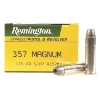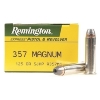First off I'll say .38 special and .357 mag are definitely not gone from LE; though they may be backup, off duty, or plain clothes guns theses days most places. We just a had junior officer come through the other day in our off duty carry class, shooting a brand new air weight and doing just fine. For the heck of it I just happened to be teaching the class with a 2" M19. Two weeks prior we had a sergeant come through with his J frame that was older then I am, and it was running along just fine.
Back in the day, I'd have to give the .357 magnum a nod for terminal effect. Pushing a bullet at almost rifle velocities pretty much guarantees it's going to expand. Penetration may occasionally be shallow as it expands too soon too fast, but it seemed as though most manufactures had it worked out fairly well after a while. The .38 Spl was handicapped by it's low velocity as it was difficult to make a bullet that would expand reliably and penetrate deep enough to do any good. Additionally police administrators then as now, didn't want to give the appearance of impropriety and the lead round nose was issued for far too long as the standard round. I don't think a less terminally effective service pistol round could have been designed then the LRN standard pressure .38 spl round. It simply gently pushes out of the way most things it encounters in the body, fails to expand or fragment, and in general doesn't tear anything. I've had a conversation with a gentleman while he walked to the ambulance with 5 through and through gunshot wounds from .38 Spl LRN bullets to the torso while I gathered suspect information and such. The victim survived, and it was probably less then a month before he was back on the same corner he was shot at with no apparent lasting impairment.
Where the .357 magnum ran into some issues historically was its velocity caused the bullet to basically explode when trying to penetrate cover if the round was designed to have large expansion consistently. On the other hand rounds that were marketed to pass work well through barriers (car bodies for instance, a common selling point to highway patrol type agencies), when they hit flesh they usually failed to expand and punched nice .357 caliber holes in the suspect. It was only moving into the early 80's the truly effective multipurpose .357 rounds started to appear for LE use. .38's terminal effect really didn't get a major boost until the same general time frame when the first "modern" hollow point designs started to be produced.
As far as practical accuracy goes, .38 had that battle won hands down. Not all cops are gun people, and they never have been. Firearms training on average in LE today is massively more effective then it was 20 years ago, and it's an order of magnitude (or two) beyond that it was in the 70's and 80's in most place. Even if recruits/cadets/rookies/etc. had some firearms experience (which is far less then the popular belief was about people back in the 40's-70's) before coming to the academy handguns were frequently not the arm they had experience with. A .38 in a service sized pistol is probably only rivaled by a .22lr revolver in ease of teaching a new shooter without developing bad habits. .357 magnum on the other hand would be one of the worst cartridges to try and teach a new shooter with (I'll put the .40 S&W right behind it, so of course what do we issue....?!). Most officers are lucky to do any shooting beyond their yearly qualification unless they fund it, so most officers historical don't shoot off duty. So in the split seconds they had to handle a life threatening situation, a .357 can (and tragically on occasion did) proved to be too much cartridge for the officer to get fast effective hits to save their lives or others.
Prior to first modern bullet designs it really was a toss up between the ability for the average officer to actually hit their target with ammunition that was lacking terminal effect to a noted degree, or shooting a round few could control that at would actually do some good if it hit the suspect. A lot of money and brain power was dedicated to try make the .38 Spl more lethal, and the .357 magnum more shootable.
Going back in history a little bit at my agency, when standardization hit sometime before WW2 as far as I can tell, we were issued M10's. We still have few that are from the 1930's in the armory (I just shot 2 of them this afternoon). After that there was a transition to the M19, and as soon as it was offered the M66. Prior to the full transition to the M19, Officers had the option of carrying their own revolver, of certain approved makes and calibers. For instance .44 special was authorized, .44 magnum wasn't. Both the M19 and M66 lasted for a good long time. When I was a rookie, and well into my years as a young patrol officer, a few old heads still carried them. At some point after that M66, the department went to the 686 for a few years (no clue why), and then transitioned to S&W 5946's. We've had auto's in some form or fashion as a personally purchased duty gun since probably the mid 90's or so (might have been a bit earlier). The last of the hold outs had to give up their revolvers in 2011.
As far as I know from talking to folks, the .357 magnum was authorized for duty carry as soon as the M19's were added to the inventory. I believe that during it's initial introduction, officers could still carry .38 Spl, but later on officers were required to carry magnums. Currently we authorize .38 spl or .357 magnum in backups, off duty, and plain clothes guns; it's the officers choice on what to load with. Prior to the complete transition to semi-auto's in 2011, only .357 magnum was authorized for uniformed duty carry.
Having done a lot of ballistic testing in my current position I've been lucky enough to see what modern rounds produced for the LE market will do. Modern .38 Spl +P rounds are basically 9mm's, they perform almost identically. I would have no issue using it on the street, and I think it's a better choice then .357 magnum in modern loadings out of a service sized handgun.
-Jenrick







